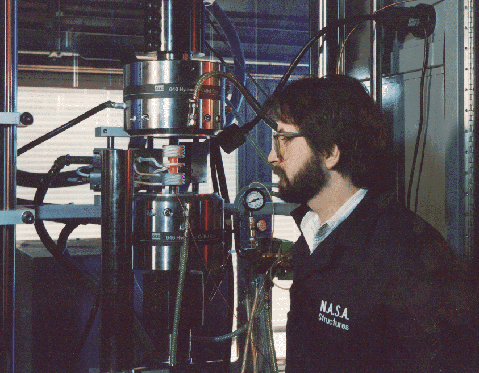 |
|||||
| Home | Research | For Teachers | HISTORY Level 1 Level 2 Level 3 |
PRINCIPLES Level 1 Level 2 Level 3 |
CAREER Level 1 Level 2 Level 3 |
| Gallery | Hot Links | What's New! | |||
| Web Administration and Tools | |||||
 |
|||||
| Home | Research | For Teachers | HISTORY Level 1 Level 2 Level 3 |
PRINCIPLES Level 1 Level 2 Level 3 |
CAREER Level 1 Level 2 Level 3 |
| Gallery | Hot Links | What's New! | |||
| Web Administration and Tools | |||||
![]()
To estimate the service lives of propulsion components with any degree of confidence, a thorough understanding of the many mechanisms that contribute to fatigue damage is necessary. The current research in this area addresses modeling the cyclic stress/strain constitutive behavior at elevated temperatures, the prediction of the crack initiation life under complex loading conditions, and the modeling of the post initiation crack propagation behavior. Fatigue damage can display complex non-linear interactions with: oxidation/hot corrosion, creep, multiaxial loading, and metallurgical instabilities. Materials systems of interest to the aerospace community and under current study include: nickel and cobalt base superalloys in polycrystalline, directionally solidified and single crystal forms; ceramic fiber reinforced metal matrix composites; monolithic ceramics; ceramic matrix composites; and polymer matrix composites.
The laboratory facilities at NASA Lewis provide many unique capabilities for the study of high temperature cyclic deformation and damage of advanced materials. Various computer controlled servo-hydraulic and electro-mechanical load frames are available to perform a wide variety of material characterizations: uniaxial testing in air or inert environments; combined axial and torsional loading; equibiaxial testing of cruciform specimens; long term tests under static loading or very low strain rates; and high-cycle, low-cycle interaction experiments. All systems have elevated temperature capability through induction, quartz lamp, direct resistance, or compact furnace heating systems. Several scanning electron microscopes have been outfitted with servo-hydraulic loading systems to study crack initiation and propagation at high magnification. This unparalleled collection of testing equipment greatly facilitates the compilation of data necessary to develop and validate life prediction models. The data collected and the analysis performed by Army and NASA researchers working together are widely distributed to the gas turbine engine community for their use in developing more durable and fuel efficient engines.
POC: Peter J. Bonacuse

Fatigue and Fracture Laboratory
![]()
Send all comments to ![]() aeromaster@eng.fiu.edu
aeromaster@eng.fiu.edu
© 1995-98 ALLSTAR Network. All rights reserved worldwide.
Updated: February 17, 1999